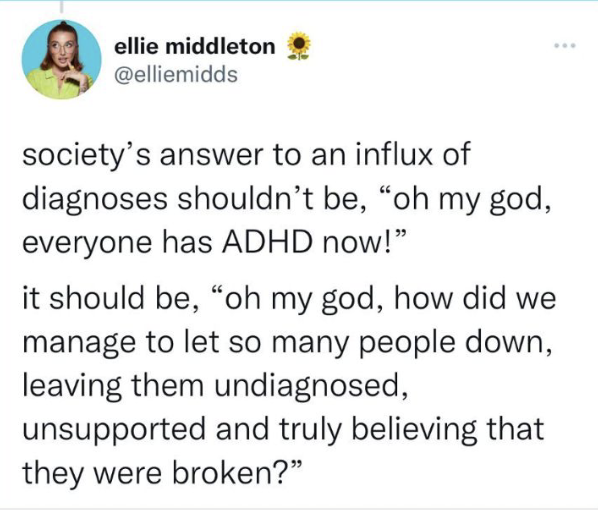Why is ADHD on the rise and am I missing out?
There’s no denying it: conversations about ADHD are more prevalent now than ever. It seems like nearly everyone knows someone who’s been diagnosed, or wonders if they might have it. But is ADHD actually increasing, or are we just seeing it more clearly? And equally important, could you be overlooking your own neurodivergence?
What does “rise” actually mean?
First, it’s helpful to unpack what “on the rise” might refer to:
More diagnoses in adults (especially late in life).
Better awareness and recognition of girls, women, and non-stereotypical presentations.
Shifts in diagnostic criteria, screening, and access to clinicians.
Increased demand for mental health services and public discussion of neurodiversity.
In Australia, ADHD is estimated to affect about 6–8% of children and 3–5% of adults (https://aadpa.com.au/ ). Globally, recent research also suggests prevalence rates remain substantial, with Australia among the higher-prevalence regions (Chen et al., 2025).
So, the “rise” isn’t necessarily a new thing; it may be a rising awareness, detection, and acceptance of neurodiversity previously hidden or so heavily stigmatised that minorities had to mask their difficulties.
Why we’re seeing more diagnoses (not a “disorder” or a disaster!)
Better awareness & shifting attitudes
There’s less stigma, more conversation, and more people speaking openly about ADHD. People are more likely to recognise traits in themselves or loved ones and seek assessment.
Improved diagnostic tools & guidelines
Australia launched updated ADHD guidelines in 2022, refining how ADHD is identified and managed in our context (https://aadpa.com.au/guideline/ ). Also, a broader understanding of inattentive or more subtle presentations (especially in females/AFAB) helps catch what was once overlooked (Brain Foundation, 2025).
The “late diagnosis” wave
Many adults live most of their lives without knowing they were neurodivergent. As awareness spreads, more adults are questioning whether their lifelong difficulties (with focus, organisation, distractibility, executive function) might stem from ADHD.
Environmental & cultural factors
Modern life, with constant stimuli, multitasking demands, digital distraction, and performance pressures, can worsen ADHD traits. In an environment that values sustained focus, what was once manageable may now feel unmanageable.
Diagnostic access
With less stigma, more accurate diagnositc tool, and more access to services, it’s not surprising that more people would be seeking support.
So…Am I missing out?
Maybe. Here are some signs that you, or someone you care about, might have undiagnosed ADHD:
Lifelong struggle with time management, planning, and deadlines
Chronic disorganisation, losing things, forgetting obligations
“Hyperfocus” on tasks you find engaging, but extreme distractibility otherwise
Emotional dysregulation: irritability, overwhelm, frustration
Masking (i.e. compensating with rules, rigid systems)
Feeling “different” in learning, working, and relationships
If these resonate (over both childhood and adulthood), it doesn’t mean a diagnosis is certain, but it might suggest exploring further.
From a neuroaffirming psychologist’s standpoint
A neuroaffirming approach reframes ADHD not as a deficit but as a difference, with its own strengths, challenges, and unique wiring. Here’s how that perspective shapes care:
Strengths-based: Focus not only on difficulties but on what your neurodivergent brain does well (creativity, divergent thinking, energy when engaged, pattern recognition).
Person-centred: Your life, goals, style, and values guide intervention; not a one-size-fits-all ADHD template.
Collaborative: You and your psychologist work together to co-design strategies (rather than “fixing” you).
Trauma-informed: Recognising how environments, marginalisation, stigma, and life demands interact with ADHD traits.
Ongoing adjustment: Strategies evolve over time as life stages shift (school, work, relationships, parenting).
What to do if you suspect ADHD (or want to explore)
Self-education & reflection
Explore credible sources (see below) and reflect on your life patterns and traits over time (not just recent stressors).
Speak to your health professionals.Screeners & informal checklists
Tools (under guidance, i.e. GP, Psychologist or Psychiatrist) can help you see whether your experiences align with ADHD traits, though they’re not diagnostic.Seek a neuroaffirming clinician
A psychologist or psychiatrist who understands ADHD from a strengths and diversity lens is ideal.Consider assessment (if indicated)
A full assessment often includes interviews, rating scales, histories, sometimes cognitive testing, and tailored feedback.Support, not cure
If diagnosed, support might include therapy, environmental modifications, habit scaffolding, assistive tech, and possibly medical treatment, all aligned with your values and goals.
Trusted Australian resources & further reading
Here are some credible Australian sites for ADHD research, information, and support:
Australian ADHD Clinical Practice Guidelines: evidence-based guidance for clinicians and patients( Australian Evidence-Based Clinical Practice Guidelines For ADHD).
Brain Foundation: ADHD overview in the Australian health context (Brain Foundation).
ND Health Hub: neurodivergent-affirming allied health care (telehealth & in-person) in Australia (ND Health Hub)
ADHD Coaching Australasia: combines coaching and therapeutic support for ADHD and broader neurodivergence. (https://adhdcoachesaustralasia.online/).
ADHD Australia: ADHD Australia actively promotes the interests of the ADHD Community in Australia (https://www.adhdaustralia.org.au/ ).
In sum
Yes, ADHD is being “noticed more,” and that’s likely a positive shift in awareness, acceptance, and access. If you’ve long felt “off-track” despite your efforts, you may have been cruising with undetected neurodivergent wiring. Exploring this possibility (with compassion and curiosity) may open up new pathways to understand you better, and to design supports that align with your brain, not against it.
If you have recently been diagnosed or are exploring whether you may be neurodivergent, then reach out to one of our Psychologists who can help you using compassionate and evidence-based strategies.
Note: The information provided in this blog is for educational purposes only and is not intended as medical /psychological advice. Please consult a healthcare professional for personalised guidance.
Note: The information provided in this blog is for educational purposes only and is NOT intended as medical /psychological advice. Please consult a healthcare professional for personalised guidance.
